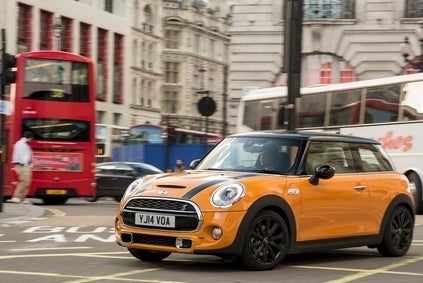
Pictures can lie – in the metal, the new Mini is easy to tell from BMW’s second generation model. But what’s it like to drive, and is the Cooper S good enough to see off its rivals?
This year is just about guaranteed to be the busiest yet for Mini. Multiple replacement models, an additional body style, and even a new production plant. Time then for a brief recap and then a gaze into the second half of 2014. The three-door car (codename: F56), which BMW Group calls Hatch in Europe and Hardtop in North America, entered production at the tail end of last year after its world premiere at the LA and Tokyo shows in November. It began arriving in UK dealerships just a couple of months ago.

Discover B2B Marketing That Performs
Combine business intelligence and editorial excellence to reach engaged professionals across 36 leading media platforms.
Since production began at Cowley, or BMW Plant Oxford, to use the factory’s official name, we’ve seen a preview of the F54 Clubman, which will probably enter production in the fourth quarter. While the Hatch is 98mm longer, 44mm wider and 7mm higher than the old-shape three-door, the next Clubman will be much larger: the concept at this year’s Geneva show was was 26cm longer and 17cm wider than the current model and also had four (frameless) passengers doors rather than three. At 4,223mm from end to end, this was also the longest Mini yet.
If you’re now wondering what F55 is, that’s the forthcoming five-door version of the Hatch and it should appear soon before entering production as the third quarter turns into the fourth. And the Cabrio replacement? F57 is said to be on course for an early 2015 debut. A ‘Traveller’ (F58) is also said to be under development – a snazzier alternative to a Meriva – as is a roadster (F59), possibly previewed by the Superleggera Vision, a concept which BMW showed at this month’s Concorso d’Eleganza Villa d’Este. Where BMW and its contract assemblers will be building all of these cars is something I’ll talk about in a moment, but clearly, Cowley has little extra capacity.
The platform for all these cars is new and shared with the BMW 2 Series Active Tourer. While we haven’t yet seen this capability, UKL1 has been designed with all-wheel drive in mind, so I would expect to see this become available for the eventual Countryman successor and if there’s a next Paceman, on that one too. With an XL-sized Clubman on the horizon, don’t be surprised if the Countryman then moves up into the C/D segment – think Qashqai or in China, long-wheelbase Yeti. Speaking of wheelbases, the one in the new Hatch has been stretched by 28mm and this is great news – for the first time in a BMW Group Mini, there is room for four adults. Boot space was another problem with the old cars and remains so for the Cabrio which is still built. Thankfully in the Hatch, it has been expanded by 51 litres, though the volume is still a squeeze 211 cubic litres.
Jump into the driver’s seat and immediately you notice a big improvement. Banished are the former effectively 2+2 layout, mishmash of hard plastic and child’s toy-like shapes on the dashboard, plus all the would-be retro toggle switches – can you tell I never really gelled with the first two generation models? Sure, they were good to drive but I just couldn’t ever see myself wanting to buy one.
Performance wise, we’re talking RS Clio-style levels of surge and the handling is much improved over the old model. Now it’s as good as not just the Renault but other class favourites such as the smaller DS 3 and Fiesta ST. The seats just envelope you, there’s more than enough shoulder and headroom but you feel snug, the head-up display shows you what you want to see and nothing that you don’t. There’s even some comedy thanks to thought bubbles with pics of a go-kart and a rocket. These appear on the central circular display the moment you select Sport mode.
The Cooper S is distinguished by a grille with a honeycomb pattern, an additional opening in the bonnet, brake air ducts integrated in the lower air inlets and a separate rear apron with exhaust tailpipes arranged at the centre. In addition to the side scuttle add-ons, the grille now also bears an ’S’ logo with chrome-effect surround. It really does look the business. Those new headlights and a more steeply angled windscreen set it apart from the old car, while at the rear, the tail-lamps are also more distinctive. Until I saw the car for myself I thought it might be tricky to tell it was the new model but its size is also another giveaway. That, and in Britain at least, the 14 registration plate.
What about the next JCW? A John Cooper Works concept previewed the as yet unseen production model at the Detroit auto show in January. Perhaps it will turn up in Chengdu in September, or more likely Paris in October or LA in November.
Mechanically, the 192bhp 2.0-litre Cooper S is more or less carried over from the old car but there is of course big news elsewhere in the model range, courtesy of a new three-cylinder engine family. The first three cars to have been launched are all turbocharged: Mini Cooper with a new 100kW/136bhp 1,499cc three-cylinder engine, Cooper S with a 141kW/192bhp 1,998cc four-cylinder engine and Cooper D with a new 1,496cc three-cylinder diesel (85kW/116bhp). A six-speed manual transmission is standard, with optional six-speed automatic transmission or sports automatic transmission.
Typically, cleverly, BMW held off launching cheaper and therefore less profitable variants, but the One and One D will be launched later in 2014. These are to be powered by 75kW/102bhp 1,233cc three-cylinder turbo petrol and 70kW/95bhp 1,496cc three-cylinder turbo diesel engines respectively. The One and One D had their debuts in three-door form at the Geneva motor show in March. Rumour has it that a 1.0-litre two-cylinder engine is due to be offered in a hybrid Mini from 2015.
As for the manufacturing story, we await news of whether or not Minis will be built at a forthcoming second Group plant in North America – it will be either the US or Mexico – but already, Cowley is being supplemented by large-scale build at a second European plant. I mustn’t forget to note that the Paceman and Countryman are already made in this region but this is courtesy of Magna Steyr’s Graz plant in Austria.
The second official Mini assembly location is to be in the Netherlands, at the same facility which once made the Volvo S40, Mitsubishi Carisma, smart forfour and a few other models too. Following the July 2012 sale agreement of Mitsubishi Motors’ NedCar plant to Dutch bus firm VDL, a deal was struck with BMW Group for the assembly of Mini vehicles. The first model, the three-door Hatch, will be assembled at Born this August. Nothing is official, but it would be reasonable to assume that Born might also make the next generation Countryman and Paceman, while providing a pressure valve for Cowley’s regular Mini bodystyle output and perhaps even be the sole source for the F54 Clubman.
According to a statement made by BMW in February, a workforce of around 1,500 people will be responsible for building cars in The Netherlands. This year, production volume at VDL NedCar “is anticipated to already reach a five-digit range”. In 2013, 303,177 Mini vehicles were produced. Plant Oxford produced 175,986 Hatch, Convertible, Clubman, Clubvan, Roadster and Coupé models. An additional 125,559 Countryman and Paceman models were built by MSF in Graz, plus an additional 1,632 units in other plants.
BMW Group and Brilliance Auto might also build the next Mini at their Tiexi plant in Shenyang but not until 2015. Nothing official has been, so announced this remains speculative, if potentially likely.
Back to the joy of living with the Cooper S. I mentioned how the seats are super-grippy. Their sporty feel is supplemented by things such as the speedo/tacho/fuel gauge cluster immediately ahead of you moving in sync with the steering wheel: just like it did in a Porsche 928 (sorry, showing my age but that was my dream car as a teenager). I mentioned flicking a switch to change the engine’s characteristics to Sport but if you prefer, there’s two other settings (see the pics).
As well as that intelligently designed steering wheel shifting, there are other impressive touches such as not needing to take your eyes off the road as you just reach over and flick the temperature buttons up or down. Why not? Cleverly, the perimeter of the central circular display glows blue or red as you do so.
The gearchange is superb – the test car was a six-speed manual – but what is it about BMW powertrains and a jerky restart from the S&S system? While I’m having a minor moan, you can’t get even the smallest water bottle into the door bins, and why don’t the mirrors fold/unfold when you blip to lock/unlock? At least you can do so manually – just touch the button on the driver’s door.
Let’s balance the criticism with some applause for there being a proper handbrake, plus I did like the glowing red switch for ignition stop or start, located in the middle of the lower dashboard below the HVAC controls. I found myself wondering if anyone else gets concerned by those hard-looking toggle switch protectors, though – my left knee was worryingly close to one of them.
Something I want to praise is the separate side sun visor just for the driver (a grab handle is in its place on the passenger side). Jaguar should learn this lesson. Both the F-TYPE Coupe and Mini Hatch need this additional sunblocker as their visors are small and quite a way forward, so BMW deserves to be singled out and its efforts noted by others.
The infotainment system in the Cooper S is excellent, as is the jukebox, and the navi system worked without fault – not always the case in on-test cars. Certain buyers might not be happy about all the instructions for the HMI being within the system itself rather than in the handbook, but a four-way controller gets you to where you want to be quickly, I found. This is located between the seats and there are also buttons down there for Media, Tel, Radio, Nav, Back and Option.
German cars used to be fantastically over-engineered and the Mini is the latest example of those days returning: the complicated hinges of the upper glovebox are a delight, even if the plastic struts are a touch on the flimsy side. To open, press on the panel ahead of you and it comes forward, then tilts upwards, revealing a space that will just about take a small bottle of water. It needs to be lined with a rubber matt, though. Really, it’s just a covering for some dead space where the steering wheel goes on LHD cars. Still, it’s good to see that BMW engineers are being allowed to design surprise and delight features, even on the Group’s cheapest models.
Without a doubt, I’m part of the target demographic for the Cooper S, so would I buy one? Yes – in a glowing red, toggle-switch heartbeat.






